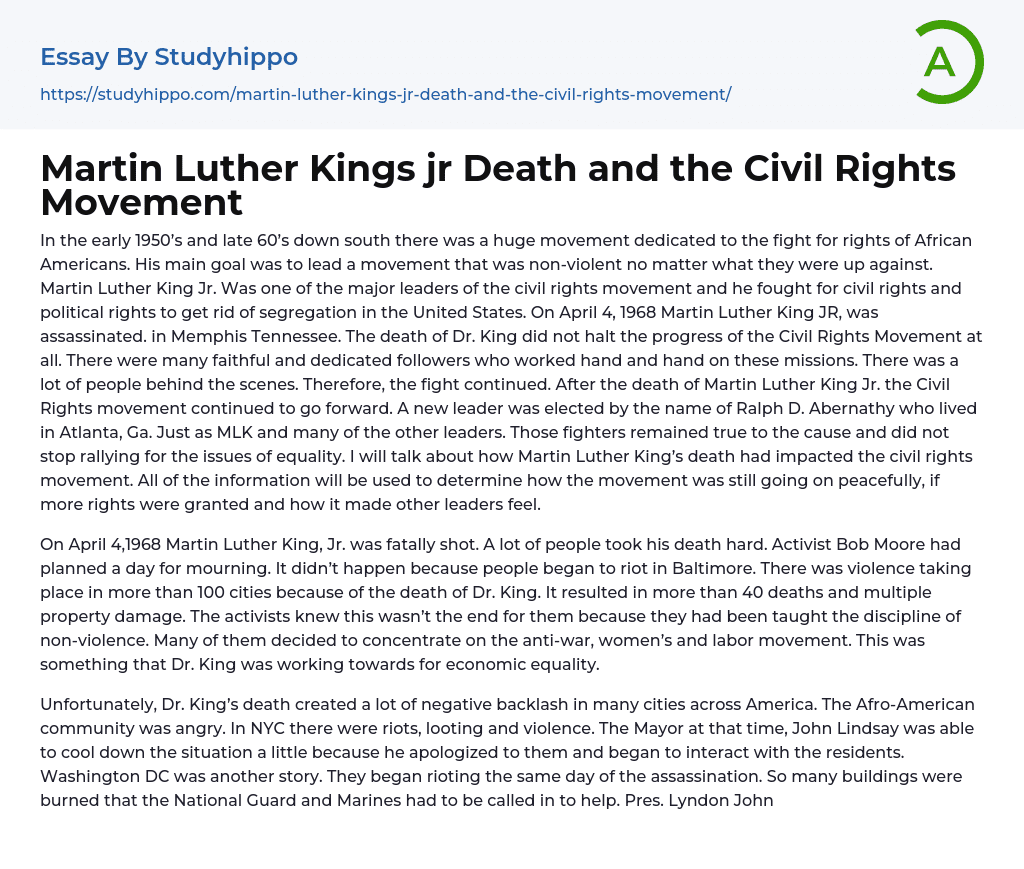

Martin Luther Kings jr Death and the Civil Rights Movement Essay Example
In the early 1950’s and late 60’s down south there was a huge movement dedicated to the fight for rights of African Americans. His main goal was to lead a movement that was non-violent no matter what they were up against. Martin Luther King Jr. Was one of the major leaders of the civil rights movement and he fought for civil rights and political rights to get rid of segregation in the United States. On April 4, 1968 Martin Luther King JR, was assassinated. in Memphis Tennessee. The death of Dr. King did not halt the progress of the Civil Rights Movement at all. There were many faithful and dedicated followers who worked hand and hand on these missions. There was a lot of people behind the scenes. Therefore, the fight continued. After the death of Martin Luthe
...r King Jr. the Civil Rights movement continued to go forward. A new leader was elected by the name of Ralph D. Abernathy who lived in Atlanta, Ga. Just as MLK and many of the other leaders. Those fighters remained true to the cause and did not stop rallying for the issues of equality. I will talk about how Martin Luther King’s death had impacted the civil rights movement. All of the information will be used to determine how the movement was still going on peacefully, if more rights were granted and how it made other leaders feel.
On April 4,1968 Martin Luther King, Jr. was fatally shot. A lot of people took his death hard. Activist Bob Moore had planned a day for mourning. It didn’t happen because people began to riot in Baltimore. There was violence takin
place in more than 100 cities because of the death of Dr. King. It resulted in more than 40 deaths and multiple property damage. The activists knew this wasn’t the end for them because they had been taught the discipline of non-violence. Many of them decided to concentrate on the anti-war, women’s and labor movement. This was something that Dr. King was working towards for economic equality.
Unfortunately, Dr. King’s death created a lot of negative backlash in many cities across America. The Afro-American community was angry. In NYC there were riots, looting and violence. The Mayor at that time, John Lindsay was able to cool down the situation a little because he apologized to them and began to interact with the residents. Washington DC was another story. They began rioting the same day of the assassination. So many buildings were burned that the National Guard and Marines had to be called in to help. Pres. Lyndon Johnson at that time imposed a series of Acts in hopes of improving conditions for the Black community. One was the Fair Housing Act of which Congress passed. In 1965, LA and Watts already had major problems within their community. They rejected the non-violent approach. The many continuous riots and violence caused lost jobs, crime increased, property de-valued and it caused more economic heartbreak. Peter Goldman wrote a short article in black America,1969 stating “We in a War –Or Haven’t Anybody Told You That? He talked about how after King’s death white America started to riot in the ghetto and any black slum in the nation. Also, after king’s assassination started a coast to coast rebellion. Goldman stated that
“more than 200 people, most of them blacks, died in the streets; that at least 10,000 were injured and 60,000 arrested and black neighborhoods were burned down”. The riots began in Harlem and it was important for social and psychic damage. They rioted in communities that didn’t believe in violence as a form of protest. Black people seen the white people rioting as a crime but rioted themselves out of black anger.
Rev. John Brooks a professor at Holy Cross College in Worcester, Ma. decided to continue the mission of Dr, King’s dream of having an Integrated Society. He recruited young Afro-American men to attend that school. He had no idea that he was recruiting future Court Justice, Clarence Thomas, Pulitzer Prize recipient Edward P. Jones and Stanley Grayson, Finance Commissioner of NYC. Attending school here was not an easy task for these young men. They almost quit over the school’s administrative handling of Afro-American anti-war issues. This era was a very confusing, troubling and angry time in history. These young men had a lot in common. They shared the same struggles where they came from and formed a deep bond by comforting and sharing visions with each other, a bond that is said to still be in effect to this day.
- Affirmative Action essays
- Assisted Suicide essays
- Capital Punishment essays
- Censorship essays
- Child Labour essays
- Child Protection essays
- Civil Rights essays
- Corporal Punishment essays
- Death Penalty essays
- Empowerment essays
- Euthanasia essays
- Gay Marriage essays
- Gun Control essays
- Human Trafficking essays
- Police Brutality essays
- Privacy essays
- Sex Trafficking essays
- Speech essays
- Abolitionism essays
- Adam Smith essays
- American History essays
- American Revolution essays
- Ancient Egypt essays
- Articles Of Confederation essays
- Atlantic Slave Trade essays
- Aztec essays
- Benjamin Franklin essays
- Civil Rights Act of 1964 essays
- Civil Rights Movement essays
- Civil war essays
- Cleopatra essays
- French And Indian War essays
- Gettysburg essays
- Great Depression essays
- Hurricane Katrina essays
- Industrial Revolution essays
- Jamestown essays
- Manifest Destiny essays
- Mccarthyism essays
- Patrick Henry essays
- Pearl Harbor essays
- Pocahontas essays
- Prohibition essays
- Pyramids essays
- Salem Witch Trials essays
- Slavery essays
- The New Deal essays
- Thirteen Colonies essays
- Westward Expansion essays
- Antisemitism essays



